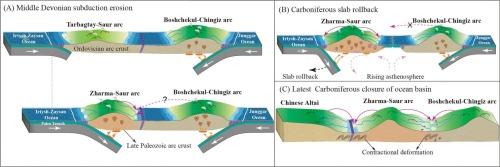中亚西南造山带沉积物源演化的证据:晚古生代额尔齐斯河-再山洋俯冲侵蚀、板块回退和闭合
IF 7.2
1区 地球科学
Q1 GEOSCIENCES, MULTIDISCIPLINARY
引用次数: 0
摘要
增生造山带以复杂的洋岩石圈俯冲过程、洋盆地的形成和闭合、弧弧碰撞为特征。中亚造山带西南部的扎尔玛-萨尔弧在晚古生代经历了额尔齐什-扎赉山洋的完整俯冲和闭合过程,但其复杂的构造演化至今仍存在争议。利用扎尔玛-萨尔弧东部晚古生代火山-沉积地层的年代学、同位素和地球化学资料,揭示了这一重要构造域的构造-沉积演化。岩性和地球化学分析表明,这些沉积物以岩浆相关碎屑为主。石炭系沉积物以晚泥盆世—石炭系锆石(376 ~ 313 Ma)为主,εHf(t)值为正(+6.7 ~ + 16.6),全部来源于扎尔马-萨尔弧。而早二叠世沉积岩的碎屑锆石年龄(2537 ~ 273 Ma)和εHf(t)值(- 13.1 ~ + 13.9)范围较广,不仅吸收了来自同一弧域的碎屑,还含有来自中国北部阿尔泰-鄂尔齐斯杂岩以及南部boshchekull - chingiz弧的碎屑锆石颗粒。根据我们的新资料,结合区域资料,令人信服地表明,中泥盆世伊尔齐什-扎伊山洋的俯冲侵蚀导致了奥陶纪塔尔巴格泰-萨尔弧的破坏。石炭系额尔齐什-扎耶山洋板块回退导致岩浆活动的后退迁移,转化为伸展环境,弧后洋盆扩张。弧后洋盆地和额尔齐斯河-宰山洋的闭合都发生在晚石炭世。该研究对这些构造过程进行了区分,并对其演化进行了表征,对于通过沉积物源分析推断古代增生造山带的构造格架具有重要意义。本文章由计算机程序翻译,如有差异,请以英文原文为准。

Evidence for Late Paleozoic subduction erosion, slab rollback and closure of the Irtysh-Zaysan Ocean from the evolving sediment provenance in the southwestern Central Asian Orogenic Belt
Accretionary orogens are characterized by complex subduction processes of oceanic lithosphere, the formation and closure of oceanic basin, and arc-arc collision. The Zharma-Saur arc in the southwestern Central Asian Orogenic Belt, had experienced the completed process of subduction and closure of the Irtysh-Zaysan Ocean during the Late Paleozoic, but controversy about its complex tectonic evolution still exists. Geochronological, isotopic and geochemistry data from Late Paleozoic volcanic-sedimentary strata in the eastern Zharma-Saur arc were conducted, aiming to decipher the tectono-sedimentary evolution of this important tectonic domain. The lithological and geochemistry analysis revealed the dominant input of magmatism-related detritus for all these sediments. The investigated Carboniferous sediments are dominated by Late Devonian–Carboniferous zircons (376–313 Ma) with positive εHf(t) values (+6.7 to + 16.6), sourced exclusively from the Zharma-Saur arc. However, the Early Permian sediment is characterized by a wide range of detrital zircon ages (2537–273 Ma) and εHf(t) values (−13.1 to + 13.9), which not only received detritus from the same arc domain but also contained detrital zircon grains sourced from the northerly Chinese Altai and Irtysh Complex, as well as southerly Boshchekul-Chingiz arc.
Based on our new data, combined with regional data, convincingly indicate that Middle Devonian subduction erosion of Irtysh-Zaysan Ocean gave rise to the destruction of the Ordovician Tarbagtay-Saur arc. Carboniferous slab rollback of Irtysh-Zaysan Ocean led to retreating migration of magmatism and transformation to an extensional setting as well as expansion of the back-arc ocean basin. The closure of the back-arc ocean basin and the Irtysh-Zaysan Ocean both occurred in the latest Carboniferous. This study distinguished these tectonic processes and characterized their evolution, which may be great importance for inferring tectonic framework of ancient accretionary orogens by sedimentary provenance analysis.
求助全文
通过发布文献求助,成功后即可免费获取论文全文。
去求助
来源期刊

Gondwana Research
地学-地球科学综合
CiteScore
12.90
自引率
6.60%
发文量
298
审稿时长
65 days
期刊介绍:
Gondwana Research (GR) is an International Journal aimed to promote high quality research publications on all topics related to solid Earth, particularly with reference to the origin and evolution of continents, continental assemblies and their resources. GR is an "all earth science" journal with no restrictions on geological time, terrane or theme and covers a wide spectrum of topics in geosciences such as geology, geomorphology, palaeontology, structure, petrology, geochemistry, stable isotopes, geochronology, economic geology, exploration geology, engineering geology, geophysics, and environmental geology among other themes, and provides an appropriate forum to integrate studies from different disciplines and different terrains. In addition to regular articles and thematic issues, the journal invites high profile state-of-the-art reviews on thrust area topics for its column, ''GR FOCUS''. Focus articles include short biographies and photographs of the authors. Short articles (within ten printed pages) for rapid publication reporting important discoveries or innovative models of global interest will be considered under the category ''GR LETTERS''.
 求助内容:
求助内容: 应助结果提醒方式:
应助结果提醒方式:


